The Old English Sheepdog, with its iconic shaggy coat and gentle demeanor, has captured the hearts of dog lovers around the world. But what makes this breed truly special?
From its rich history to its unique appearance, there is much to discover about the Old English Sheepdog. So, let's embark on a journey to uncover the fascinating traits and characteristics of this beloved breed.
Key Takeaways
- Old English Sheepdogs are a British dog breed known for their gentle and affectionate temperament, making them great companions for children and other pets.
- Despite their size, Old English Sheepdogs can adapt well to apartment living as long as they have low-energy levels and are well-mannered indoors.
- When choosing a dog for an apartment, size should not be the only factor to consider. It is important to prioritize qualities such as being quiet, low-energy, and well-behaved.
- Old English Sheepdogs require significant exercise and daily grooming due to their profuse, shaggy coats. They are also prone to certain health issues such as hip dysplasia and cataracts.
Origin and History
The Old English Sheepdog's origin and history can be traced back to the southwestern counties of England. This breed has a rich history rooted in the herding and driving of livestock. It's believed that the Old English Sheepdog's ancestors were brought to England by the Romans, and over time, they developed into the iconic breed we know today.
Their thick, shaggy coat and sturdy build made them well-suited for the harsh weather conditions and rugged terrain of the region. They were primarily used for herding sheep and cattle, and their intelligence and working instincts made them invaluable to farmers.
Today, the Old English Sheepdog is cherished for its friendly nature and iconic appearance, and it continues to be a beloved companion and show dog around the world.
Size and Lifespan
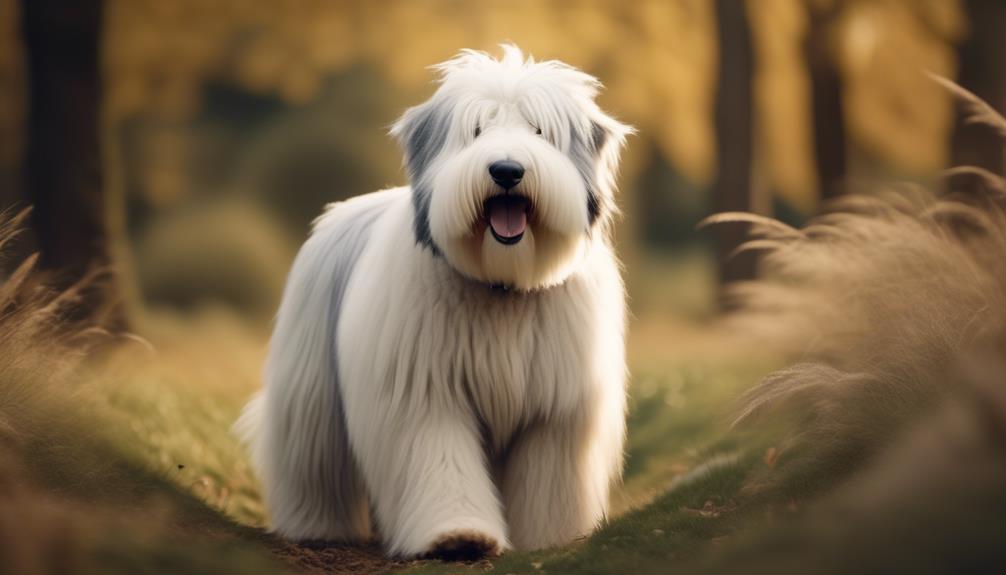
Originating in the southwestern counties of England, the Old English Sheepdog's size and lifespan make it a distinctive breed with unique characteristics. Here are some key points to grab your attention:
- Size: Males stand 22 inches tall and weigh 80 to 100 pounds, while females stand 21 inches tall and weigh 60 to 85 pounds.
- Lifespan: On average, Old English Sheepdogs live for 10 to 12 years, providing long-term companionship.
- Health: Although generally healthy, they're prone to certain conditions like canine hip dysplasia, cataracts, progressive retinal atrophy, hypothyroidism, and deafness.
With their large size and relatively long lifespan, Old English Sheepdogs require dedicated care and attention. It's important to understand the specific needs and potential health issues associated with this breed to ensure their well-being and happiness.
Coat and Appearance
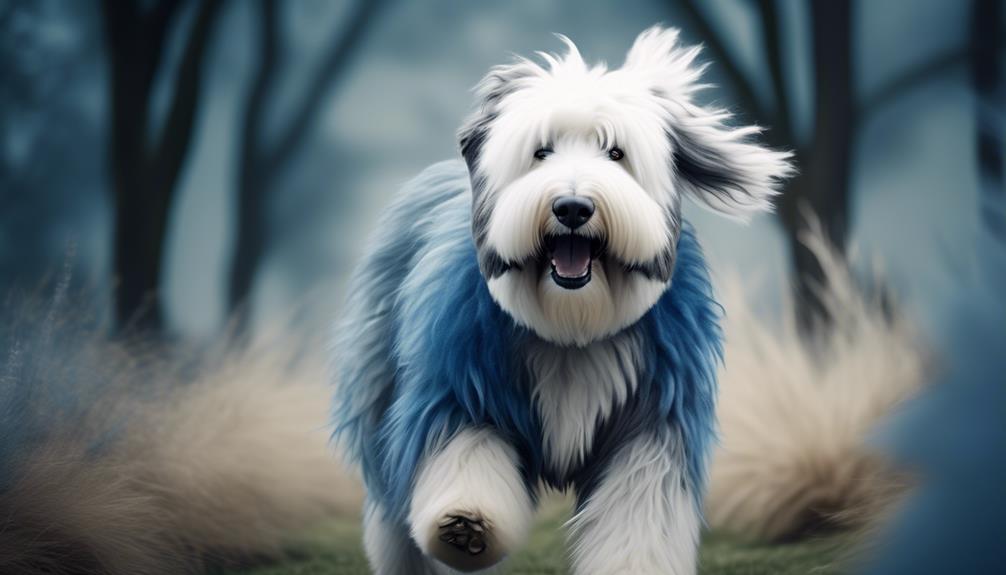
With its distinctive and shaggy appearance, the coat of the Old English Sheepdog is one of its most defining features. The breed has a long, double coat that's typically blue or gray with white markings. The thick and dense outer coat is weather-resistant, providing protection against harsh elements. Meanwhile, the soft and woolly undercoat helps to insulate the dog's body.
This coat requires regular grooming to prevent matting and ensure cleanliness. Daily brushing is necessary to remove tangles and keep the coat healthy. Additionally, occasional bathing is recommended to keep the coat fresh and free from dirt.
The Old English Sheepdog's coat gives it a teddy bear-like appearance, adding to its charm and appeal.
Temperament and Personality
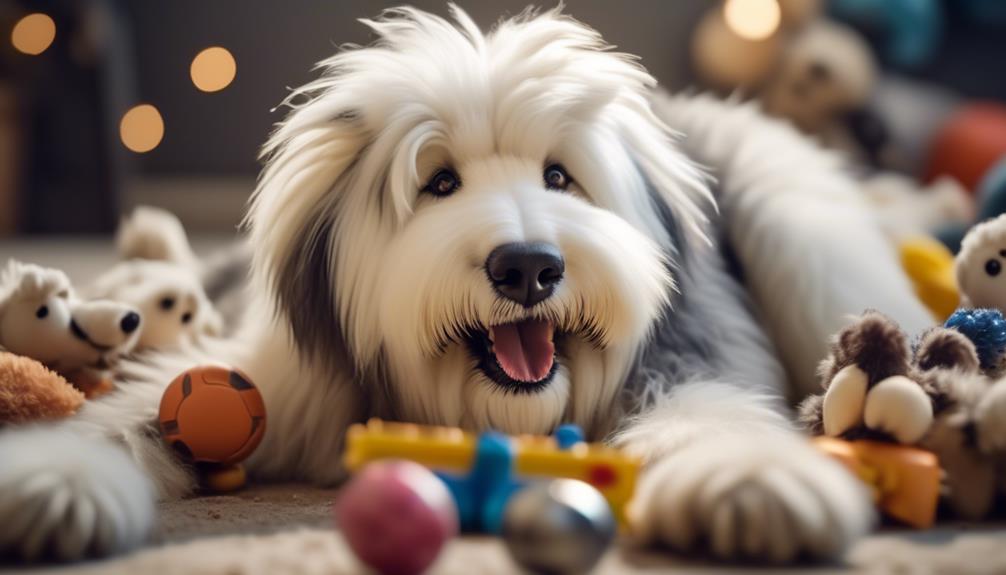
Playful and affectionate, the Old English Sheepdog is known for its charming personality. Here are some key traits that make this breed stand out:
- Highly Intelligent: Old English Sheepdogs are quick learners and excel in obedience training.
- Great with Children: They have a patient and gentle nature, making them excellent companions for kids.
- Sociable and Friendly: This breed is known for their friendliness towards both humans and other animals.
Their loving and playful nature makes them a great addition to any family. Whether it's playing fetch in the backyard or cuddling on the couch, the Old English Sheepdog is always up for some quality time.
Their affectionate personality and love for companionship make them a cherished member of the household.
Adaptability to Apartment Living
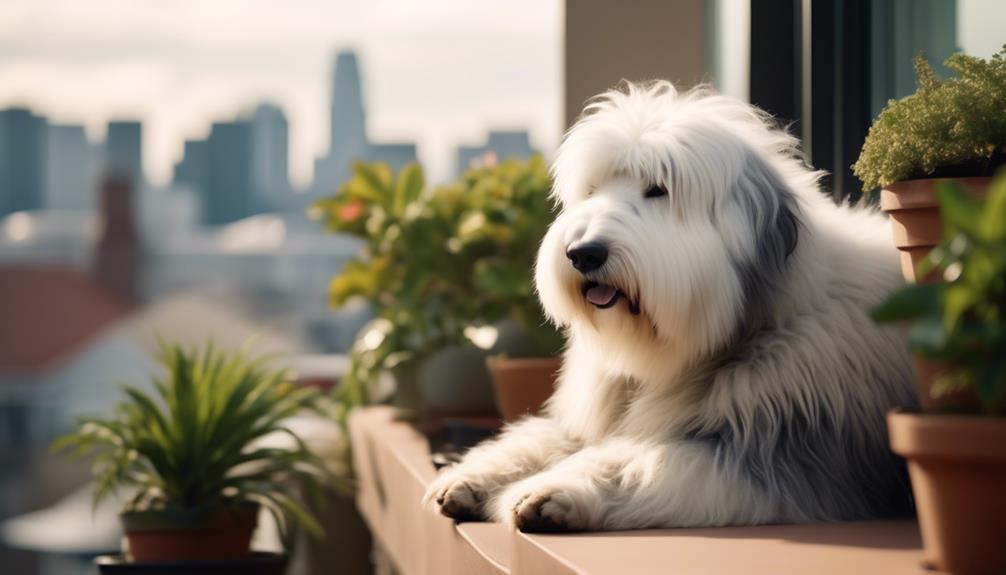
The Old English Sheepdog demonstrates adaptability to apartment living by being well-suited to a quieter and more confined living environment. Despite their larger size, they have a gentle and low-energy temperament, which makes them suitable for apartment living.
Size alone shouldn't be the sole determinant for apartment suitability, as certain small breeds with higher energy levels can still thrive in apartments. However, the Old English Sheepdog's calm and well-mannered nature makes them an excellent choice for apartment dwellers. They aren't prone to excessive barking or howling, which helps to maintain a peaceful living environment.
Additionally, their adaptability extends to their exercise needs, as they can be satisfied with moderate daily exercise.
Factors to Consider for Apartment Living
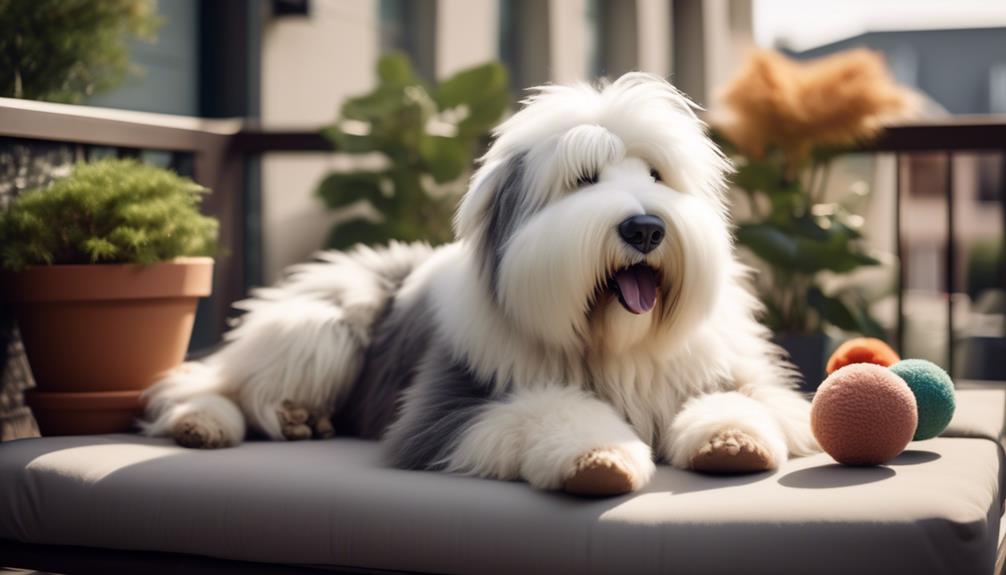
Considering the unique challenges of apartment living, there are several important factors to take into account when choosing a dog.
- Size isn't the only factor to consider. Some larger breeds can adapt well to apartment living with lower energy levels.
- Certain small breeds with higher energy levels can still thrive in apartments.
- Prioritize qualities such as being quiet, low-energy, calm indoors, and well-mannered.
When living in an apartment, it's crucial to select a dog that can adapt to the limited space and potential noise restrictions. While size is a consideration, it isn't the sole determinant for apartment suitability. Some larger breeds can have lower energy levels and be well-suited for apartment living. On the other hand, certain small breeds with higher energy levels can still thrive in apartments if they receive adequate exercise and mental stimulation.
It's also important to prioritize qualities such as being quiet, low-energy, calm indoors, and well-mannered to ensure the comfort and well-being of both the dog and the neighbors.
Considerations for Breeds Not Suited to Apartments
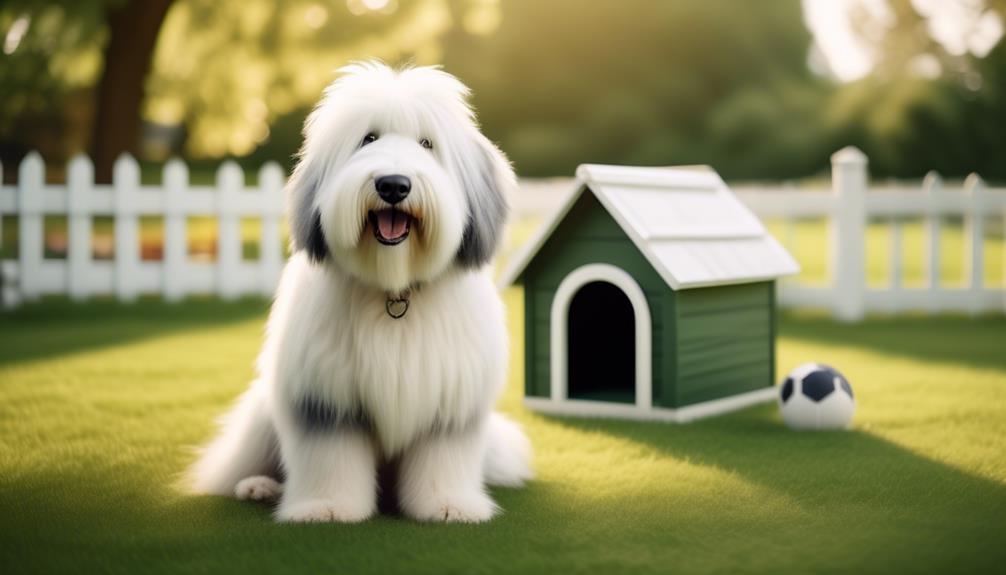
Breeds not suited to apartments often display characteristics such as high aggression, excessive barking, and a strong wanderlust potential. These breeds are typically larger in size and require ample space to roam and exercise.
Their high energy levels and need for mental stimulation make apartment living challenging for them. Additionally, their tendency to bark excessively can disturb neighbors and lead to complaints.
Moreover, breeds with a strong wanderlust potential may have difficulty adjusting to the confined space of an apartment and may try to escape whenever given the chance.
It's important for potential dog owners to carefully consider the breed's temperament, exercise needs, and overall suitability for apartment living before making a decision.
Old English Sheepdog Specific Information
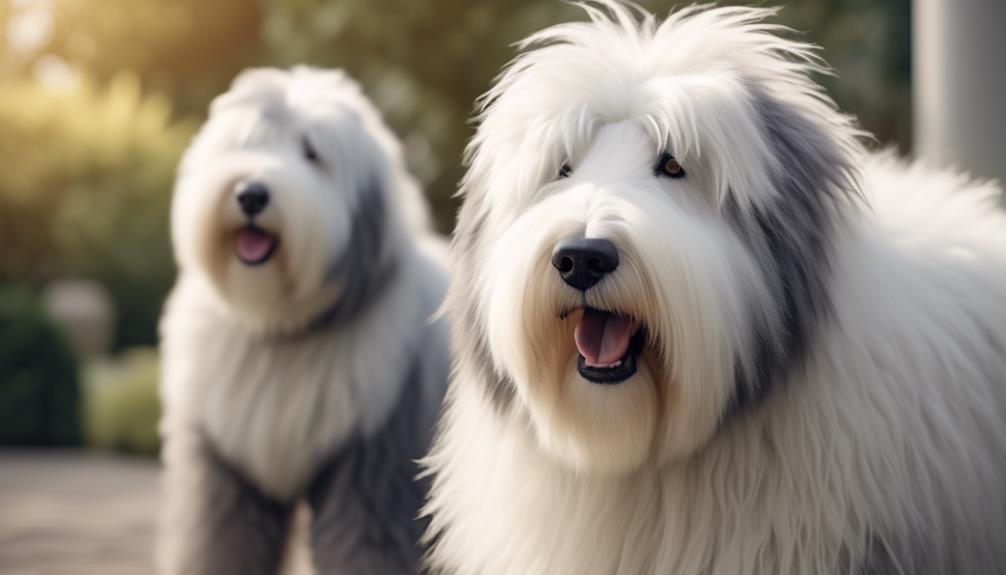
With a playful and affectionate personality, the Old English Sheepdog is an intelligent breed that requires significant exercise and makes an excellent companion for children. Here are some specific details about the Old English Sheepdog:
- Size: Males stand 22 inches tall and weigh 80 to 100 pounds, while females stand 21 inches tall and weigh 60 to 85 pounds.
- Health: This breed is prone to canine hip dysplasia, cataracts, progressive retinal atrophy, hypothyroidism, and deafness.
- Care: Old English Sheepdogs require one to two hours of daily exercise, and obedience training is encouraged. Caution should be taken with crate training.
- Feeding: It's recommended to feed them 2.5 to 4.5 cups of high-quality dry food per day, watching for overfeeding and weight gain.
- Coat color and grooming: They've a profuse, shaggy coat in various colors, and extensive grooming is required with daily brushing.
- Children and other pets: Well-bred and well-socialized Old English Sheepdogs are trustworthy companions for children, but supervision is crucial.
- Rescue groups and breed organizations: There are various organizations dedicated to rescuing and promoting responsible breeding of Old English Sheepdogs.
Health and Care
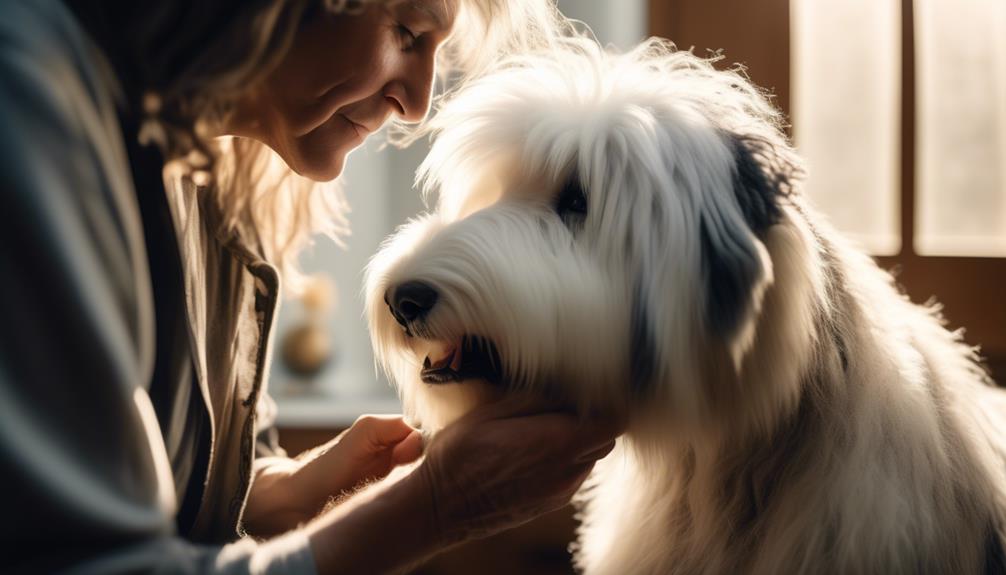
The health and care of the Old English Sheepdog are essential aspects to consider for this breed. Like any dog, regular veterinary check-ups are important to ensure their overall well-being.
The Old English Sheepdog is prone to certain health conditions including canine hip dysplasia, cataracts, progressive retinal atrophy, hypothyroidism, and deafness.
It's crucial to provide them with one to two hours of daily exercise to keep them physically and mentally stimulated. Obedience training is also encouraged to ensure they're well-behaved.
When it comes to feeding, it's recommended to give them 2.5 to 4.5 cups of high-quality dry food per day, while monitoring their weight to avoid overfeeding.
Additionally, their profuse and shaggy coat requires daily brushing and regular grooming to prevent matting.
Children and Other Pets
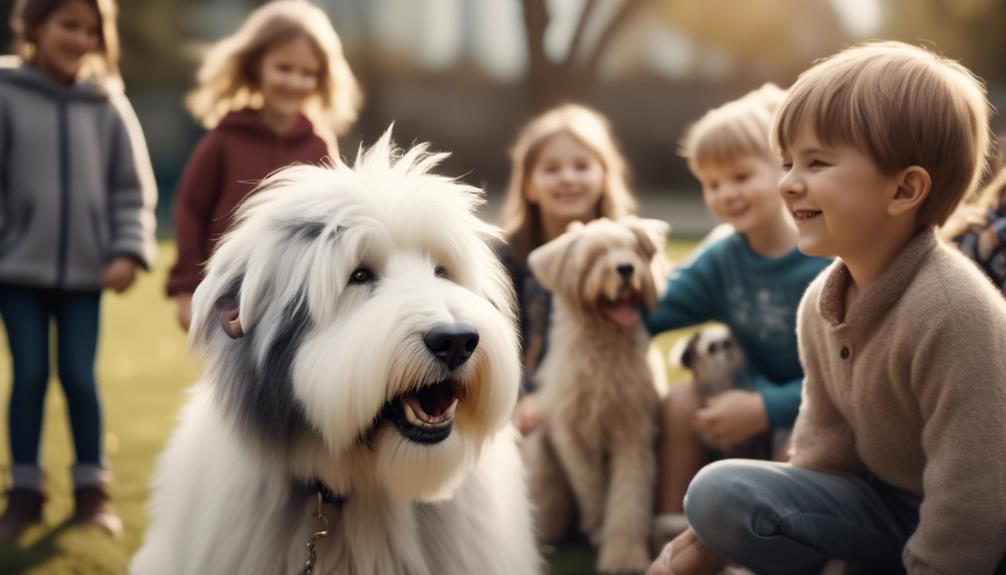
When considering the Old English Sheepdog's suitability for families, it's important to understand their compatibility with children and other pets. Here are some key points to consider:
- Gentle and affectionate: Old English Sheepdogs are known for their gentle and loving nature, making them great companions for children.
- Good with other pets: With proper socialization, these dogs can get along well with other pets in the household.
- Supervision is crucial: While Old English Sheepdogs are generally good with children, supervision is still important to ensure safe interactions.
Frequently Asked Questions
Are Old English Sheepdogs Hypoallergenic?
Old English Sheepdogs are not hypoallergenic. They have a profuse, shaggy coat that requires extensive grooming. While they are good-natured and make excellent companions, their coat can trigger allergies in some individuals.
How Often Should an Old English Sheepdog Be Groomed?
An Old English Sheepdog should be groomed regularly to maintain their profuse, shaggy coat. Grooming should include daily brushing to prevent matting and tangles, as well as regular bathing and trimming as needed to keep them looking their best.
Do Old English Sheepdogs Shed a Lot?
Yes, Old English Sheepdogs shed a lot. Their profuse, shaggy coat requires extensive grooming with daily brushing. Regular grooming can help manage shedding, but be prepared for their hair to be everywhere.
Are Old English Sheepdogs Good Guard Dogs?
Old English Sheepdogs are not typically good guard dogs. While they are large and have a protective nature, they are more known for their gentle and affectionate temperament rather than being aggressive or alert guard dogs.
Can Old English Sheepdogs Be Left Alone for Long Periods of Time?
Old English Sheepdogs should not be left alone for long periods of time. They are affectionate and require companionship. Leaving them alone for extended periods can lead to separation anxiety and behavioral issues.
What are the similarities and differences between the Old English Sheepdog and the Irish Water Spaniel?
The Irish Water Spaniel breed info highlights the similarities and differences between this breed and the Old English Sheepdog. Both breeds are known for their intelligence and trainability. However, the Irish Water Spaniel is a sporting dog, while the Old English Sheepdog is a herding dog, with different grooming and exercise requirements.
Conclusion
In conclusion, the Old English Sheepdog is a wonderful companion for apartment living due to its gentle nature and adaptability. Despite its size, this breed is known for being calm and well-behaved indoors.
With proper exercise, grooming, and care, the Old English Sheepdog can thrive in an apartment setting. However, it's important to consider the specific needs and energy levels of any dog breed before making a decision.




